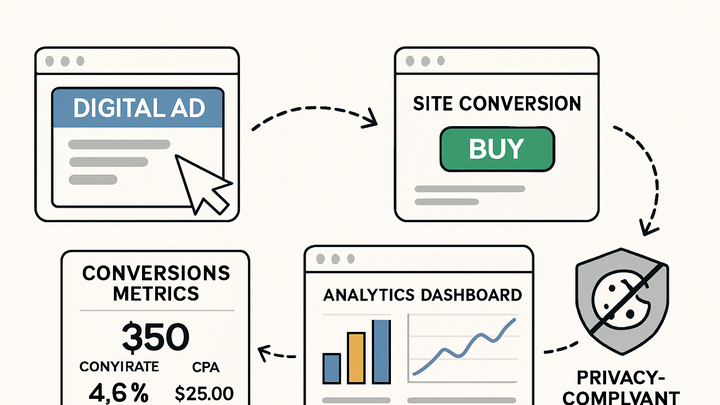Published on 2025-06-22T09:01:36Z
What is Post-Click Conversion? Examples and Best Practices
In analytics, a post-click conversion refers to the event when a user completes a desired action—such as filling out a form or making a purchase—after clicking on an advertisement or promotional link. This metric focuses solely on user behavior that follows a click, distinguishing it from post-impression conversions, which may happen without direct clicks. Tracking post-click conversions provides clear visibility into the effectiveness of ad creative, keywords, and landing pages by tying specific click interactions to outcomes. It’s an essential KPI for optimizing paid campaigns, improving ROI, and allocating budgets to high-performing channels. Modern analytics platforms like PlainSignal and Google Analytics 4 (GA4) offer robust ways to capture and analyze post-click data while balancing user privacy and compliance. PlainSignal’s cookie-free approach simplifies implementation and compliance, whereas GA4 provides extensive customization and cross-platform tracking capabilities. By understanding and accurately tracking post-click conversions, organizations can make data-driven decisions that directly influence revenue growth.
Post-click conversion
Measures user actions after clicking ads or links, crucial for evaluating campaign effectiveness and ROI.
Understanding Post-Click Conversion
This section defines post-click conversions, explains how they differ from other attribution metrics, and describes why they matter for digital marketers.
-
Core definition
A post-click conversion is any tracked action a user takes on your site after clicking an ad or link. Common examples include form submissions, sign-ups, and purchases.
-
Post-click vs post-impression
Post-click conversions require a direct click to trigger tracking. Post-impression conversions can occur after an ad view without a click, often relying on view-through attribution.
Importance in Analytics
Learn why post-click conversion metrics are critical for measuring campaign success and optimizing marketing spend.
-
Measuring campaign effectiveness
Tie ad clicks directly to outcomes to see which creatives, keywords, and channels drive the most conversions.
-
Optimizing marketing roi
Allocate budget to high-performing campaigns by analyzing cost per acquisition (CPA) based on post-click events.
Implementing Post-Click Conversion Tracking
Step-by-step integration guides for capturing post-click conversions with PlainSignal and GA4.
-
Tracking with PlainSignal
To integrate post-click conversion tracking with PlainSignal, include the following snippet in your site’s
<head>:<link rel='preconnect' href='//eu.plainsignal.com/' crossorigin /> <script defer data-do='yourwebsitedomain.com' data-id='0GQV1xmtzQQ' data-api='//eu.plainsignal.com' src='//cdn.plainsignal.com/plainsignal-min.js'></script>Once installed, use the PlainSignal dashboard to define conversion events and verify in real-time reports.
-
Install snippet
Paste the provided code into the
<head>of every page you want to track. -
Configure conversion event
In PlainSignal’s UI, set up the desired event (e.g.,
purchaseorform_submit). -
Verify data
Check real-time analytics to ensure your conversion event fires correctly after a click.
-
-
Configuring post-click conversions in GA4
In Google Analytics 4, send conversion events via gtag.js. Example:
<script async src='https://www.googletagmanager.com/gtag/js?id=G-XXXXXXXXXX'></script> <script> window.dataLayer = window.dataLayer || []; function gtag(){dataLayer.push(arguments);} gtag('js', new Date()); gtag('config', 'G-XXXXXXXXXX'); gtag('event', 'purchase', { 'transaction_id': 'T12345', 'value': 99.99, 'currency': 'USD' }); </script>Then mark the
purchaseevent as a conversion in the GA4 interface.-
Setup GA4 property
Ensure you have a GA4 property with a valid measurement ID.
-
Define conversion events
In GA4, navigate to Events and toggle your key events as conversions.
-
Validate tracking
Use Realtime and DebugView to confirm your events fire after clicks.
-
Best Practices and Common Pitfalls
Guidelines to ensure accurate post-click reporting and avoid common tracking mistakes.
-
Ensure data accuracy
Avoid duplicates and ensure tags fire correctly across pages and devices.
-
Deduplicate events
Use unique identifiers for transactions or actions to avoid double counting.
-
Consistent naming conventions
Adopt a standardized event naming scheme across all platforms.
-
-
Handle cross-device tracking
Track users across sessions and devices to get a complete view of conversions.
-
Enable user-id
Implement User-ID in GA4 to link sessions from the same user across devices.
-
Leverage privacy-safe ids
Use PlainSignal’s cookie-free IDs to respect user privacy while maintaining continuity.
-
-
Respect privacy and compliance
Ensure your tracking practices comply with regulations like GDPR and CCPA.
-
Consent management
Use consent banners and GA4 Consent Mode to manage user permissions.
-
Cookie-free tracking
Utilize PlainSignal’s cookie-free analytics to reduce reliance on cookies.
-
